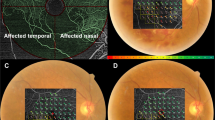Abstract
Background
In the follow-up of retinal vein occlusions, a patient’s subjective change in vision frequently cannot be confirmed by objective measurements. Furthermore, contradictory results of OCT and distance visual acuity give the impression that current routine diagnostic tests might not be satisfying for patients with retinal vein occlusions. This prospective case series analyses the value of microperimetry as a routine diagnostic test in the follow-up of patients with retinal vein occlusions during therapy.
Methods
In a prospective case series, we tested microperimetry as a functional measure in comparison to distance visual acuity, reading ability, and OCT, on 13 patients treated for central or branch retinal vein occlusions. Treatment consisted of intravitreal bevacizumab injections combined with panretinal laser coagulation in cases of peripheral ischemia. If macular edema persisted, bevacizumab injection was repeated, or instead of this intravitreal triamcinolone or focal laser coagulation was applicated. Follow-up ranged from 6–14 months. An interim analysis was performed for the 6-month follow-up.
Results
In the branch retinal vein occlusion group, the average of the retinal thickness measured by OCT was 502.22 μm (±SD 217.75 μm) at baseline and changed to 396.38 ± 154.38 at the 6-month follow-up (p = 0.121). Mean distance visual acuity stayed similar to the study entrance with 0.41 ± 0.34 at the 6-month follow-up (p = 0.944) Mean reading ability improved to 0.51 ± 0.52 at the 6-month follow-up but was not statistically significant (p = 0.435). The mean light sensitivity of microperimetry improved from baseline to the 6-month follow-up: the 40-points group improved from 8.62 ± 5.69 dB to 10.98 ± 5.42 (p = 0.060) and the 8-points group from 6.27 dB to 9.6 dB (p = 0.07) but missed statistical significance. The sector group showed in contrast to this an improvement from 6.02 ± 5.71 dB to 9 ± 6.07 dB (p = 0.025), which was statistically significant. Changes in the central vein occlusion group were not statistically significant but changes for both groups together showed statistical significance.
Conclusions
In the present case series, microperimetry was more convenient to detect, even the subtle functional changes during the disease course of branch retinal vein occlusions than distance and reading visual acuity. This indicates that microperimetry could be a possible valuable tool in the follow-up of branch retinal vein occlusions.



Similar content being viewed by others
References
Brown DM, Kaiser PK, Michels M, Soubrane G, Heier JS, Kim RY, Sy JP, Schneider S (2006) ANCHOR study group: ranibizumab vs. verteporfin for neovascular age-related macular degeneration. N Engl J Med 355:1432–1444
Rosenfeld PJ, Brown DM, Heier JS, Boyer DS, Kaiser PK, Chung CY, Kim RY (2006) Ranibizumab for age-related macular generation. MARINA study. N Engl J Med 355:1419–1431
Massin P, Bandello F, Garweg JG, Hanssen LL, Harding SP, Larsen M, Mitchell P, Scharp D, Wolf Schnurrbusch UE, Gekkieva M, Weichselberger A, Wolf S (2010) Safety and efficacy of ranibizumab in diabetic macular edema (RESOLVE Study): a 12-month, randomized, controlled, double-masked, multicenter phase II study. Diabetes Care 33(11):2399–2405
Nicholson BP, Schachat AP (2010) A review of clinical trials of anti-VEGF agents for diabetic retinopathy. Graefes Arch Clin Exp Ophthalmol 248(7):915–930
Kampik A, Priglinger S (2008) Intravitreal bevacizumab for the treatment of macular oedema secondary to branch vein occlusion. Br J Ophthalmol 92:351–355
Jaissle GB, Leitritz M, Gelisken F (2009) One-year results after intravitreal bevacizumab therapy for macular oedema secondary to branch retinal vein occlusion. Graefes Arch Clin Exp Ophthalmol 247:27–33
Kiss CG, Barisani-Asenbauer T, Simader C, Maca S, Schmidt-Erfurth U (2008) Central visual field impairment during and following cystoid macular oedema. Br J Ophthalmol 92:84–88
Rohrschneider K, Bueltmann S, Springer C (2008) Use of fundus perimetry (microperimetry) to quantify macular sensitivity. Prog Retinal Eye Res 27:536–548
Ferris FL, Kassoff A, Bresnick GH, Bailey I (1982) New visual acuity charts for clinical research. Am J Ophthalmol 94:91–96
Radner W, Willinger U, Obermayer W (1998) Eine neue Lesetafel zur gleichzeitigen Bestimmung von Lesevisus und Lesegeschwindigkeit. Klin Monatsbl Augenheilkd 213:174–181
Stifter E, Konig F, Lang T, Bauer P, Richter-Müksch S, Velikay-Parel M, Radner W (2004) Reliability of a standardized reading chart system: variance component analysis, test-retest and inter-chart reliability. Graefes Arch Clin Exp Ophthalmol 242:31–39
Morwood SL (2000) Research strategies for advanced practice nurses. Prentice Hall Health, New Jersey
du Prel JB, Hommel G, Röhrig B, Blettner M (2009) Confidence interval or p-value?: part 4 of a series on evaluation of scientific publications. Dtsch Arztebl Int 106(19):335–339
Ach T, Hoch A, Schaal K, Scheuerle AF, Dithmar S (2009) Predictive factors for changes in macular edema in intravitreal bevacizumab therapy for retinal vein occlusion. Graefes Arch Clin Exp Ophthalmol. doi:10.1007/s00417-009-1167-6
Kriechbaum K, Prager F, Geitzenauer W, Benesch T, Schütze C, Simader C, Schmidt-Erfurth U (2009) Association of retinal sensitivity and morphology during antiangiogenic treatment of retinal vein occlusion over one year. Opthalmology 116:2415–2421
Senturk F, Ozdemir H, Karacorlu M, Karacorlu S, Uysal O (2010) Mircoperimetric changes after intravitreal triamcinolone acetonide injection for macular edema due to central retinal vein occlusion. Retina 30:1254–1261
Midena E, St V, Convento E, Manfré A, Cavarzeran F, Pilotto E (2007) Microperimetry and fundus autofluorescence in patients with early age- related macular degeneration. Br J Ophthalmol 91:1499–1503
Competing interests and funding
The authors have no competing interests or funding.
Author information
Authors and Affiliations
Corresponding author
Rights and permissions
About this article
Cite this article
Winterhalter, S., Lux, A., Maier, A.K. et al. Microperimetry as a routine diagnostic test in the follow-up of retinal vein occlusion?. Graefes Arch Clin Exp Ophthalmol 250, 175–183 (2012). https://doi.org/10.1007/s00417-011-1784-8
Received:
Revised:
Accepted:
Published:
Issue Date:
DOI: https://doi.org/10.1007/s00417-011-1784-8




